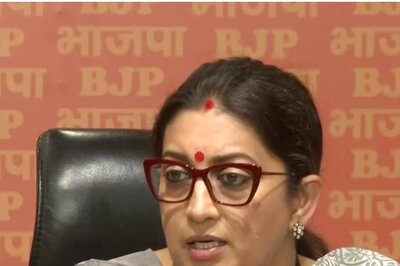
views
Many people today are familiar with the character of Robert Langdon, the protagonist in the Robert Langdon series of novels by celebrated American author Dan Brown. Langdon, the intriguing symbologist (symbology is a fictitious discipline that denotes the study of historical symbols) often finds himself decoding ancient riddles and verses for hidden wisdom to solve different cases. This often reminds me of some real instances of encoding and decoding in our own backyard.
A particular shloka or verse (Gopibhagya Madhuvraatah, Shrumgashodadhi Samdhigah, khalajeevitakhatava Galahaala Rasandhara) in the Rig Veda, for example, has a very interesting hidden meaning when you decode it with another ancient formula. On the surface the shloka can either be interpreted as a praise of Lord Krishna or that of Lord Shiva. But if we decode it with a formula ‘Kadi Nava, Tadi Nava, Padi Panchaka, yadyashtaka, khsadi shunya’( meaning ka=1, kha=2, ga=3, gha=4, gna= 5, cha=6, ccha=7, ja=8. Jha=9; ta=1, tha=2, da=3, dha=4, na=5, Ta=6, Tha=7, Da=8, Dha=9; pa=1, pha=2, ba=3, bha=4, ma=5; ya=1,ra=2, la=3, va=4, Sa=5, sha=6, sa=7, ha=8 & khsa=0 ) we get the value of pi upto the 32nd decimal places.
However, the purpose of this encoding and decoding was not for secrecy but in order to make memorising easier. Ancient Indian mathematicians often used this technique to memorise complex values and formulas. It is an example of how the ancient scholars created techniques to memorise large numbers and formulas.
The pi shloka is a tiny example of the vast treasure of knowledge hidden in our ancient Sanskrit texts. Besides the value of pi, the ancient Hindu mathematicians are also credited with the invention of calculus, quadratic equations, decimal, zero and a lot of other stuff.
But Sanskrit texts are not just treasures containing numbers and numerical formulas. It is a well-documented fact that ancient Sanskrit texts contain scientific findings that are strikingly similar to modern discoveries in the field of astronomy, metallurgy, etc. Indians had a very clear understanding of planetary motions, elliptical orbits, etc. Ancient texts like Sushruta Samhita tell us about surgery and even cosmetic surgery.
In fact, Sushruta is called the first surgeon in the world. The most famous example is the description of nose reconstruction surgery by Sushruta. This technique was even used by Indian doctors recently to reconstruct the nose of an Afghan patient.
Similarly, texts like Charaka Samhita contain a huge repository of knowledge on herbs. The list is inexhaustible. There are plenty of such other texts that contain knowledge acquired through ages as well as scientific and mathematical wonders. Sanskrit texts have intrigued researchers for ages. These texts not only hold the key to ancient knowledge but also are a source of insight into our history. We can go on and on mentioning the ancient knowledge that is found in Sanskrit texts. What we need today is extensive research into these texts.
One primary reason why Sanskrit texts can provide unadulterated view of our past is that the language itself has not changed over time unlike the languages used for day-to-day use. Every language changes its form with time. Its expressions, its words, they may all change meaning with time. Sanskrit has remained in its unadulterated form for ages and, therefore, the messages in the texts are still in their original form (apart from the case of texts that have been rewritten or modified).
Sanskrit has suffered at the hands of both its opponents and its diehard enthusiasts. On one hand, there is the extremely ignorant and myopic outlook of dismissing the study of Sanskrit as unnecessary and unscientific in the name of progressive thinking. But on the other hand, the call to make it a language for day-to-day use in the name of promoting the language has negative effects on it. The moment Sanskrit becomes a language of day-to-day use it will change its form.
New words will enter the vocabulary and existing words will metamorphose into new ones. Thus, within a few decades the language will change and chances are that a significant amount of knowledge will be lost in transition or later translations. We must avoid the extreme approaches of treating the language either as a ‘symbol of a particular faith which should not be acceptable to other faiths’ or as a ‘divine language that fell from the skies’ for the sake of our own benefit.
Sanskrit is a language that was used to document knowledge as well as to create literature. During its formative days, the language was influenced by other regional languages spoken at that time. But for most part of its existence, it has resisted changes owing to its highly structured and strict grammatical rules. As a ‘dead language’, we can say it has been in a ‘pure form’ (without attaching divinity to the term ‘pure’) for centuries. Let us not try to adulterate it by hoping to make it a language for day to day use.
Research on Sanskrit texts, on the other hand, is very important not just for academic purposes but also for economic benefits. Don’t we remember how Sanskrit texts and their study compelled the US Patent and Trademark office to withdraw the patent on turmeric that it had granted in 1995? Similarly, Sanskrit texts helped India win the Basmati rice patent case as well.
Knowledge of Sanskrit is a key to unlock the huge repository of knowledge of ancient India. Contrary to popular belief, Sanskrit knowledge traditions did not flourish in the Ganga valley alone. There were equally rich Sanskrit knowledge traditions in South India, Kashmir, Kamrupa (today’s Assam) etc. Research into these texts also holds a mirror to the historical narratives of these regions.
It is one of the oldest documented languages of the Indo-European language family and therefore holds a prominent position in Indo-European studies. It is one of the three oldest documented languages sharing a common root called the Proto Indo European or PIE.
From the earliest known Vedic Sanskrit of the 2nd century BCE, a more standardised and classical form of Sanskrit evolved in the mid 1st century BCE. Panini standardised the language in his treatise Astadhayi and this form has been called Classical Sanskrit. Vedic Sanskrit has links to various other ancient languages of the world, including Greek, Hittite, Latin, Gothic, etc. scattered around the world. Thus, research and study of Sanskrit holds a key to the ancient history of the world as well.




















Comments
0 comment